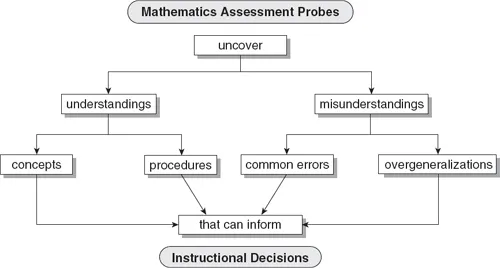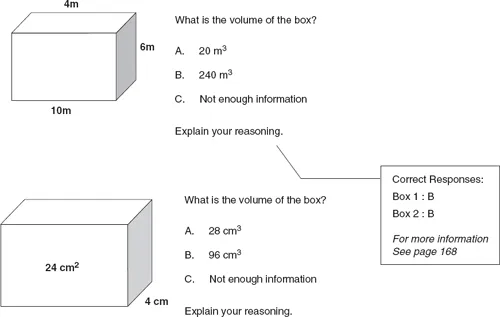
Uncovering Student Thinking in Mathematics
25 Formative Assessment Probes
- 200 pages
- English
- ePUB (mobile friendly)
- Available on iOS & Android
Uncovering Student Thinking in Mathematics
25 Formative Assessment Probes
About this book
—From the Foreword by Anne Davies
"A fresh and unique resource for mathematics teachers who recognize the importance of carefully establishing the starting points of instruction in terms of what students already know. The collection of assessment probes is inventive, engaging for students, and invaluable for teachers."
—Richard H. Audet, Associate Professor, Roger Williams University
Use formative assessment probes to take the guesswork out of mathematics instruction and improve learning!
Students learn at varying rates, and if a misconception in mathematics develops early, it may be carried from year to year and obstruct a student?s progress. To identify fallacies in students? preconceived ideas, Uncovering Student Thinking in Mathematics offers educators a powerful diagnostic technique in the form of field-tested assessment probes—brief, easily administered activities to determine students? thinking on core mathematical concepts.
Designed to question students? conceptual knowledge and reveal common understandings and misunderstandings, the probes generate targeted information for modifying mathematics instruction, allowing teachers to build on students? existing knowledge and individually address their identified difficulties.
Linked to National Council of Teachers of Mathematics standards, this invaluable handbook assists educators with:
- 25 ready-to-use mathematical probes
- Teacher guides for implementing each probe at any grade level
- Examples of typical obstacles and faulty thinking demonstrated by students
This rich resource combines standards, educational research findings, and practical craft knowledge to help teachers deliver informed instruction that strengthens all students? learning and achievement in mathematics.
Frequently asked questions
- Essential is ideal for learners and professionals who enjoy exploring a wide range of subjects. Access the Essential Library with 800,000+ trusted titles and best-sellers across business, personal growth, and the humanities. Includes unlimited reading time and Standard Read Aloud voice.
- Complete: Perfect for advanced learners and researchers needing full, unrestricted access. Unlock 1.4M+ books across hundreds of subjects, including academic and specialized titles. The Complete Plan also includes advanced features like Premium Read Aloud and Research Assistant.
Please note we cannot support devices running on iOS 13 and Android 7 or earlier. Learn more about using the app.
Information
1
Mathematics
Assessment Probes
- Determine a question
- Use a probe to examine student understandings and misunderstandings
- Use links to cognitive research to drive next steps in instruction
- Implement the instructional unit or activity
- Determine the impact on learning by asking an additional question
WHAT TYPES OF UNDERSTANDINGS AND MISUNDERSTANDINGS DOES A MATHEMATICS ASSESSMENT PROBE UNCOVER?
Understandings: Conceptual and Procedural Knowledge
Conceptual Understanding
- Recognize, label, and generate examples and nonexamples of concepts
- Use and interrelate models, diagrams, manipulatives, and so on
- Know and apply facts and definitions
- Compare, contrast, and integrate concepts and principles
- Recognize, interpret, and apply signs, symbols, and terms
- Interpret assumptions and relationships in mathematical settings

Procedural Knowledge
- Select and apply appropriate procedures
- Verify or justify a procedure using concrete models or symbolic methods
- Extend or modify procedures to deal with factors in problem settings
- Use numerical algorithms
- Read and produce graphs and tables
- Execute geometric constructions
- Perform noncomputational skills such as rounding and ordering (U.S. Department of Education, 2003, Chapter 4)
- “Volume is the area of the base times the height. If you flip this box, the 24 is the base and 4 is the height so 24 cm2 × 4 cm is 96 cm3.” Figure 1.2 Volume of a Box Probe

- “You already have some of the information needed. If you rearrange l × w × h to fit the information given, you would have (l × h) × w. You are given that l × h is 24 cm2 and (24 cm2) (4 cm) = 96 cm3.”
Misunderstandings: Common Errors and Overgeneralizations
Common Error Patterns
Table of contents
- Cover Page
- Dedication
- Title
- Copyright
- Contents
- Foreword by Anne Davies
- Preface
- Acknowledgments
- About the Authors
- Chapter 1: Mathematics Assessment Probes
- Chapter 2: Instructional Implications
- Chapter 3: Number and Operations Assessment Probes
- Chapter 4: Algebra, Data Analysis, and Probability Assessment Probes
- Chapter 5: Geometry and Measurement Assessment Probes
- Resource A: Note Template
- References
- Index